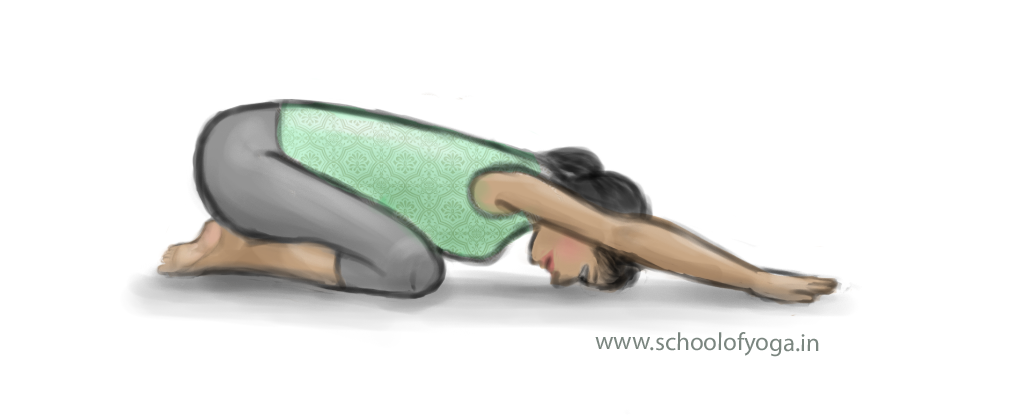School of Yoga explains Variation 1 of Veerasana- Adhomukha Veerasana (Downward facing dog virility pose)

Adhomukha Veerasana technique:
- Sthithi (starting) position: Sit in Vajrasana. Ensure that the hip joint, knee joint and ankle are aligned.
- Place your hand on the knees, palm down covering the knees.
- Ensure that the genitals are comfortably placed between the thighs and not pressurised.
- Slowly increase pressure of the buttocks on the ankles till the ankles are completely stretched but not uncomfortable. However, this could take time and practice.
- Raise your hand over the head. Breathe in.
- Breathing out, slowly fold your torso over the thigh till the face touches the ground. Ensure that, the hand touches the ground also.
- Stretch the hand as far forward as possible. Keep for 10 counts.
- Breathing in, come erect.
- Breathing out, bring hands over the knees.
- Breathe normally. Repeat 2 to 4 times.
- The drishti (gaze) recommended is focus on svadishtana chakra.
- For best results, it is important that there is minimal gap at the knee and hip joints.
Adhomukha Veerasana benefits:
- The full benefit of the asana can be derived only if there is complete stretching of the lower back, shoulders, hip, thighs, hamstrings and calves. Consequently, this energises and strengthens all the posterior lower torso, lumbar region and muscles. Also, there is enormous increase in flexibility in the lower region.
- The back muscles of the thigh, the hamstring muscles, quadriceps and calf muscles are strengthened. Therefore, this asana is very good for treating all forms of early knee and hip arthritis issues.
- There is enormous stretching, compression and tension created by this asana at the knee and hip joints. However, to get maximum benefit one should attempt to reach a tight knee and hip joint lock.
- The bending forward brings 3 way compression of the genitals and generates heat. This is supposed to increase brahmacharyam (celibacy), quality of the seminal fluid and consequently virility (veeryam).
- Very good for stabilising menstrual issues.
- The compression of the abdominal viscera on the thighs improves digestion and evacuation.
Variation 2: Supta veerasana (supine virility asana)

Supta Veerasana technique:
- Sthithi (starting) position: Sit in Vajrasana. Ensure that the hip joint, knee joint and ankle are in the same line. Place your hand on the knees, palm down covering the knees.
- Ensure that the genitals are comfortably placed between the thighs and not pressurised.
- Slowly increase pressure of the buttocks on the ankles till the ankles are completely stretched but not uncomfortable. This could take time and practice. Breathe in.
- Breathing out, using the hands as support, slowly go backwards till the torso touches the ground.
- Take your hand over the head and join together in anjali mudra.
- Stretch the hand as far forward as possible. Keep for 10 counts.
- Breathing in, come erect.
- Breathing out, bring hands over the knees.
- Breathe normally. Repeat 2 to 4 times.
- The drishti (gaze) recommended is focus on svadishtana chakra.
- For best results, it is important that there is minimal gap at the knee and hip joints.
Supta Veerasana benefits:
- This asana increases flexibility at the knee and ankle. However, it is important to realise that the pressure on the ankle by the descending torso could result in pain.
- Stop if there is pain and move the feet outwards to reduce the direct pressure on the ankles.
Variation 3: Eka pada supta veerasana – one leg stretched
Eka pada supta Veerasana technique:
- Sthithi (starting) position: Sit in Vajrasana. Ensure that the hip joint, knee joint and ankle are in the same line. Place your hand on the knees, palm down covering the knees.
- Ensure that the genitals are comfortably placed between the thighs and not pressurised.
- Slowly increase pressure of the buttocks on the ankles till the ankles are completely stretched but not uncomfortable. This could take time and practice. Breathe in.
- Remove one foot from under the buttock and stretch it forward.
- Breathing out, using the hands as support, slowly go backwards till the torso touches the ground.
- Take your hand over the head and join together in anjali mudra.
- Stretch the hand as far forward as possible. Keep for 10 counts.
- Breathing in, come erect.
- Breathing out, bring hands over the knees.
- Breathe normally. Repeat 2 to 4 times.
- The drishti (gaze) recommended is focus on svadishtana chakra.
Veerasana contraindications:
- Do not perform this asana if you are suffering from extreme arthritis.
- Do not perform this asana during menstruation or pregnancy.
Some noteworthy points on veerasana:
Internal Links: Dharma (conditioning), Stress and Situational Awareness, Prana, Asana overview 1, Asana Overview 2, Asana Focus or gazing, Pranayama,
External Links: Prana, Chakra, Pancha Tattva, Pancha Prana, Pancha Kosha, Nadi,
- It may be difficult to sink down vertically. One could bend slightly forward to relieve the pressure on the knee.
- It is important to remember that the primary objective of this asana is conservation of seminal fluid and secretions.
- The subsidiary benefits are increased flexibility of the ankles, knees, hips and lower back.